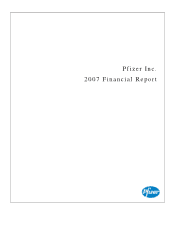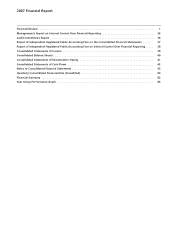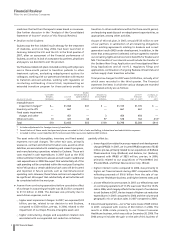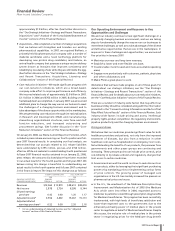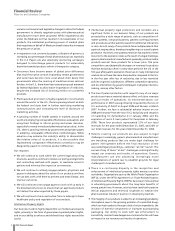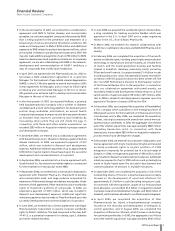Pfizer 2007 Annual Report Download - page 6
Download and view the complete annual report
Please find page 6 of the 2007 Pfizer annual report below. You can navigate through the pages in the report by either clicking on the pages listed below, or by using the keyword search tool below to find specific information within the annual report.
4 2007 Financial Report
Financial Review
Pfizer Inc and Subsidiary Companies
remains controversial and legislative changes to allow the federal
government to directly negotiate prices with pharmaceutical
manufacturers have been proposed. While expanded access
under the Medicare Act has resulted in increased sales of our
products, the substantial purchasing power of medical plans
that negotiate on behalf of Medicare beneficiaries has increased
the pressure on prices.
•In response to cost concerns by payers, utilization of generics is
increasing as a percentage of total pharmaceutical use, especially
in the U.S. Payers are also selectively sponsoring campaigns
designed to interchange generic products for molecularly
dissimilar branded products within a therapeutic category.
•Consumers have become aware of global price differences
that result from price controls imposed by certain governments
and some have become more vocal about their desire that
governments allow the sourcing of medicines across national
borders. In the U.S., there have been several proposals advanced
by federal legislators to allow easier importation of medicines,
despite the increased risk of receiving inferior or counterfeit
products.
•Pharmaceutical promotion is highly regulated in most markets
around the world. In the U.S., there is growing interest at both
the federal and state level in further restricting marketing
communications and increasing the level of disclosure of
marketing activities.
•A growing number of health systems in markets around the
world are employing comparable effectiveness evaluations and
using their findings to inform pricing and access decisions,
especially for newly introduced pharmaceutical products. In the
U.S., there is growing interest by government and private payers
in adopting comparable effectiveness methodologies. While
adoption may enhance the industry’s ability to demonstrate
the relative value of its products, it is also possible that
implemented comparative effectiveness conventions may be
designed by payers to minimize product differences.
Our response:
•We will continue to work within the current legal and pricing
structures, as well as continue to review our pricing arrangements
and contracting methods with payers, to maximize access to
patients and minimize the impact on our revenues.
•We will continue to actively engage patients, physicians and
payers in dialogues about the value of our products and how
we can best work with them to prevent and treat disease, and
improve outcomes.
•We will continue to encourage payers to work with us early in
the development process to ensure that our approved products
will deliver the value expected by those payers.
•We will continue to be a constructive force in helping to shape
healthcare policy and regulation of our products.
Intellectual Property Rights
Our business model is highly dependent on intellectual property
rights, primarily in the form of government-granted patent rights,
and on our ability to enforce and defend those rights around the
world.
•Intellectual property legal protections and remedies are a
significant factor in our business. Many of our products are
protected by a wide range of patents, such as composition-of-
matter patents, compound patents, patents covering processes
and procedures and/or patents issued for additional indications
or uses. As such, many of our products have multiple patents that
expire at varying dates, thereby strengthening our overall patent
protection. However, once patent protection has expired or been
lost prior to the expiration date as the result of a legal challenge,
generic pharmaceutical manufacturers generally produce similar
products and sell those products for a lower price. This price
competition can substantially decrease our revenues for products
that lose exclusivity, often in a very short period in the U.S. in the
first year after patent expiration. Revenues in many international
markets do not have the same sharp decline compared to the U.S.
in the first year after loss of exclusivity, due to less restrictive
policies on generic substitution, different competitive dynamics,
and less intervention by government/payers in physician decision-
making, among other factors.
•The loss of patent protection with respect to any of our major
products can have a material adverse effect on future revenues
and our results of operations. As mentioned above, our
performance in 2007 was significantly impacted by the loss of
U.S. exclusivity of Zoloft in August 2006 and Norvasc in March
2007. Further, we face a substantial adverse impact on our
2008 performance from the loss of U.S. exclusivity and cessation
of marketing for Zyrtec/Zyrtec D in January 2008, and the
expiration of our U.S. basic patent for Camptosar in February
2008. These four products represented 12% of our total
revenues for the year ended December 31, 2007, and 20% of
our total revenues for the year ended December 31, 2006.
•Patents covering our products are also subject to legal
challenges. Increasingly, generic pharmaceutical manufacturers
are launching products that are under legal challenge for
patent infringement before the final resolution of the
associated legal proceedings—called an “at-risk” launch. The
success of any of these “at-risk” challenges could significantly
impact our revenues and results of operations. Generic
manufacturers are also advancing increasingly novel
interpretations of patent law to establish grounds for legal
challenges to branded patents.
•There is a continuing disparity in the recognition and
enforcement of intellectual property rights among countries
worldwide. Organizations such as the World Trade Organization
(WTO), under the WTO Agreement on Trade-Related Aspects
of Intellectual Property Rights (TRIPS), have been instrumental
in educating governments about the long-term benefits of
strong patent laws. However, activists have used both putative
ethical arguments and technical loopholes to weaken the
pharmaceutical industry’s position in developing markets.
•The integrity of our products is subject to an increasingly predatory
atmosphere, seen in the growing problem of counterfeit drugs,
which can harm patients through a lack of active ingredients, the
inclusion of harmful components or improper accompanying
packaging. Our ability to work with law enforcement to
successfully counter these dangerous criminal activities will have
an impact on our revenues and results of operations.

